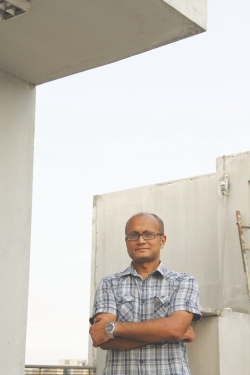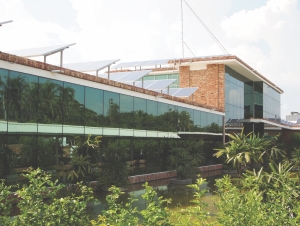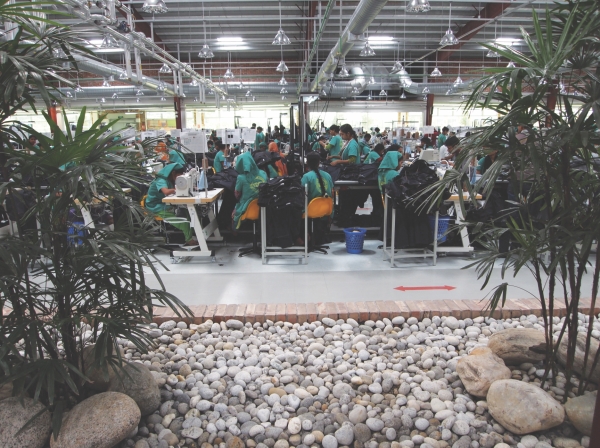| Home - Back Issues - The Team - Contact Us |
 |
| Volume 11 |Issue 40| October 12, 2012 | |
|
|
Achievment
LEEDing the Way Bangladeshi factory is the world's first LEED Platinum award winner Maya Barolo Vintage Denim Studio (VDS) in the Ishwardi EPZ has become the first factory in the world to receive the US Green Building Council's prestigious Leadership in Energy and Environmental Design (LEED) Platinum V3 award, putting Bangladesh in the forefront of green technology and design. The brains behind the award winning factory is Dhaka-based architect Rahat Choudhury. But Choudhury is quick to direct the credit for the award to the vision of ABA Group Chairman and Vintage Denim Studio owner, Sajjadur Rahman, who spared no expense in creating a world-class facility. Not willing to settle for silver or gold, Rahman set his eyes on Platinum certification, saying, "if we're going to go green, let's go all the way". Adamant that this factory should be an example not only to Bangladesh but to the world, Rahman spent an extra Tk 20.7 crore to make the purpose-built garment factory eco-friendly enough to win the world's top-rated green award. In fact, Rahman and his CEO Duminda Mangala were so committed to setting a precedent for environmental and social responsibility that they invested in additional green innovations that went beyond the LEED Platinum requirements. Built with only locally-sourced materials and labour, the factory has an extensive water treatment facility that saves nearly two million gallons of water each year. Through the strategic use of skylights, solar tubes and large windows, the factory relies nearly exclusively on natural light; LED task lights switch on automatically only when the centrally controlled Building Management System (BMS), which apart from monitoring light also regulates temperature and air quality, senses that the sky is overcast. The solar panels installed on the factory roof generates 150,000 watts a year, which meets an impressive 10 percent of the total energy needs of the factory.
The 2,50,000 square foot factory, with over 2,000 employees, boasts over 45 percent reductions in energy and water consumption and a substantially lowered carbon footprint. The green-minded design of the building means not only tangible energy savings and reduced operating costs, but also numerous intangible benefits, including a more conducive work environment and improved health and safety for the workers. But most importantly it sets an example both within the industry and society at large. As companies are becoming more and more image conscious, the incentive of prestigious awards like LEED certification will set the bar higher. While it has become common practice for factories to have on-site hospital clinics, creches and daycare programmes, foreign buyers are increasingly demanding improved green credentials before placing their orders. Competition from neighbouring India and China, as well as the emerging economy of Myanmar, means that Bangladeshi companies will have to find new ways to keep ahead in the global market. The green innovations implemented in the factory are impressive both in terms of quantity and quality. But what is most striking is the joint vision and commitment of the architect and Chairman to create a pleasant and welcoming work environment. The factory workers enter the compound, which looks more like a sprawling university campus than an industrial complex, through a landscaped courtyard, surrounded by ponds and greenery. Noting that most of the employees have spent much of their lives working in the fields and are unfamiliar with the concrete confines of conventional factories, Choudhury is pleased to see that they congregate around the water and landscaped gardens during their rest hour.
The vast majority of the workers, most of whom are drawn from the surrounding areas, are women. The socio-economic benefits of female employment have been well documented throughout the country and the case of VDS is no exception. VDS's presence in Ishwardi is making a difference not only to the national economy, but also to the local community. Bangladesh, like many developing countries, contributes least to the causes of global warming and yet suffers most from the consequences. But Choudhury is optimistic about the future of green design, saying, "if we are able to do it in Bangladesh, with limited resources and only the strength of our vision, then we are now on the right path". He is confident that other Bangladeshi companies will follow the example set by ABA Group and says that he has already received several commissions from other clients who want LEED-certified buildings. Choudhury, who is also an assistant professor of architecture at the University of Asia Pacific, tries to instill in his students a commitment to the environment and the community, teaching them that "it is not only about the building but about the environment you are creating."
|
||||||||
|


